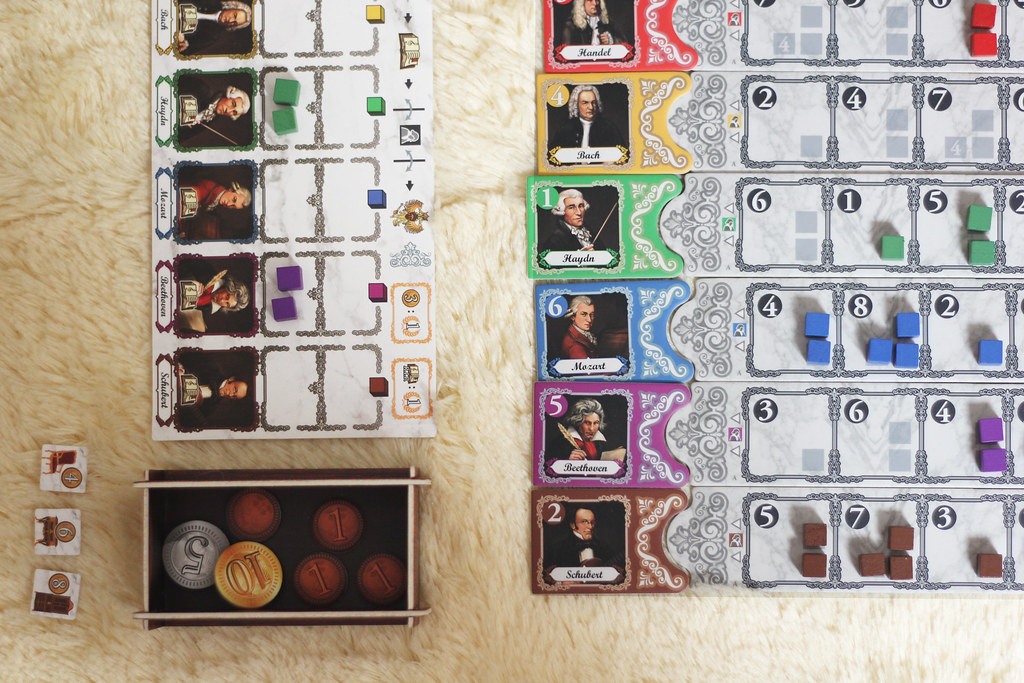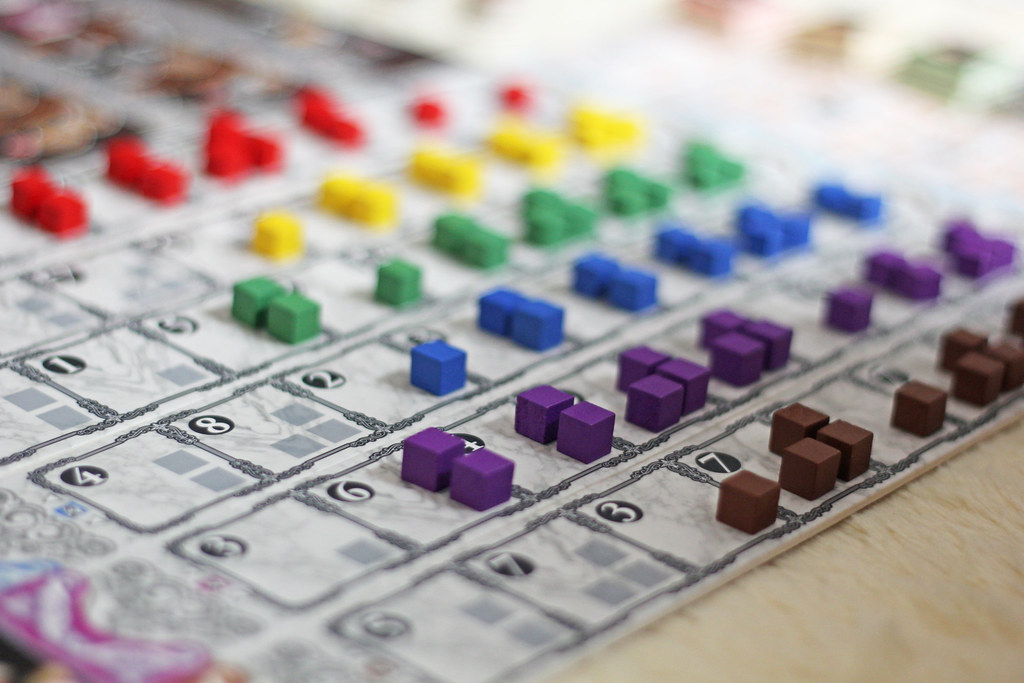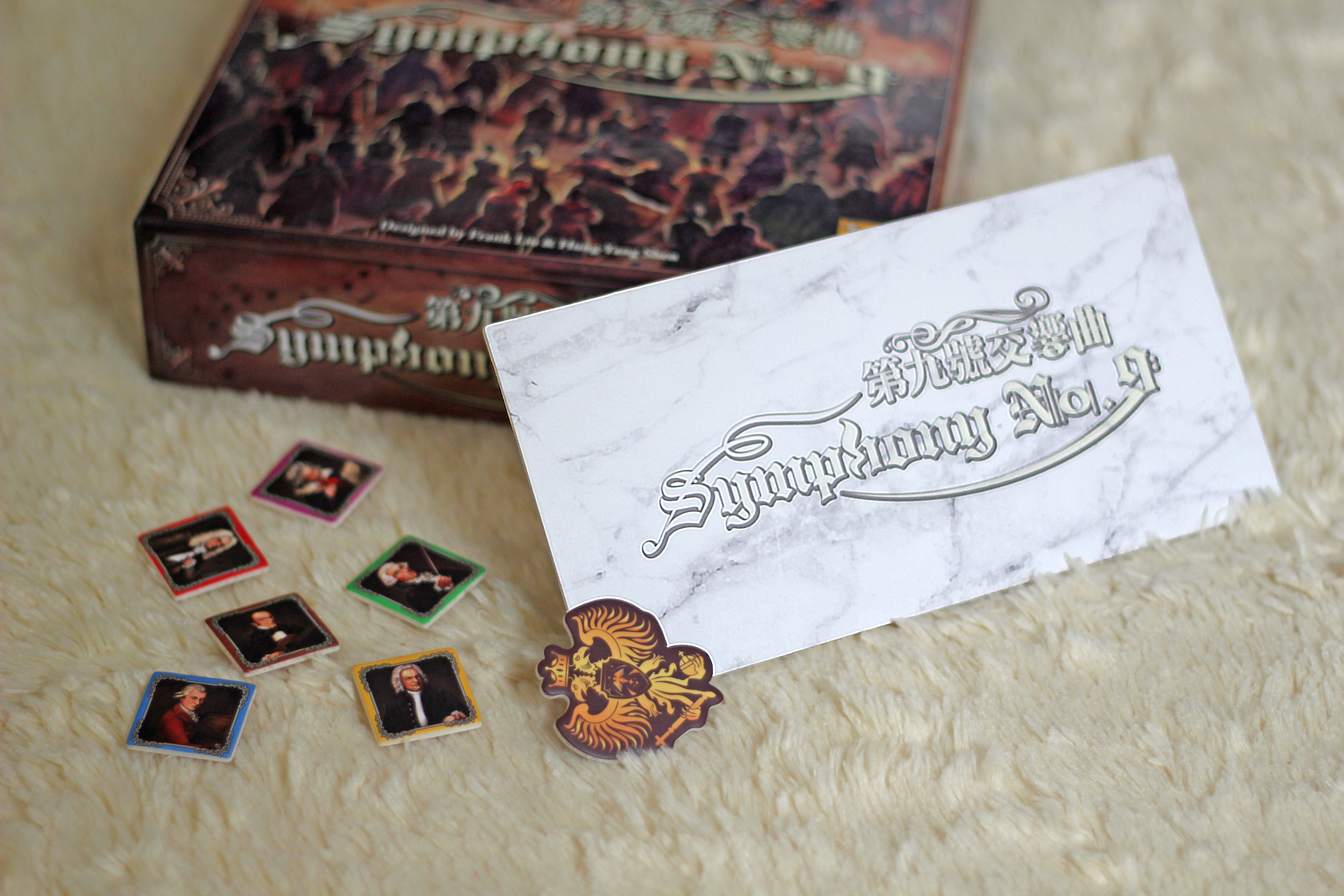Symphony No. 9 is a board game published by Moaideas Game Design. When I heard about this game, I keep repeating to myself, “I definitely have to try this board game!” And that’s exactly what I did. Well, classical music has always had a special place in my heart. Nothing beats enjoying a cup of coffee and eating warm French toast accompanied by the alluring music of Vivaldi’s Four Seasons or Pachelbel’s Canon in D. If you are curious, you can listen to the alluring Beethoven’s Symphony No. 9 here.
Symphony No. 9’s Overview
Frank Liu and Hung-Yang Sen were the designers of Symphony No. 9. Stephan met Moaideas Game Design, the publisher, in Spiel Essen 2018. Read his report here to get to know more!
In this game, you are a noble during the golden era of classical music who patrons famous composers, such as Beethoven, Bach, Mozart, etc. to gain ownership to their latest musical compositions, which in turn will be performed in concerts financed by you and the other nobles. Successful concerts will give you money depending on whether you have ownership of the compositions being performed or not, while a failed concert will penalize you.
Setting up the game
To set up Symphony No. 9, first, place the double-sided concert board in the middle of the table. Choose the side depending on the number of players. Take 6 random royal tokens and place it face down on the available spaces.

Then, arrange the composer tiles on their respective career track and place the donation cubes on the career tracks according to the colours. These tracks are also double-sided: side A represents the actual ups-and-downs of each musician in history, whereas side B is completely randomized. Note that only 5 musicians are used in a 2-3 players game (sorry, Schubert!) Place the end-game scoring tiles at the end of the tracks and the composition tiles to each corresponding composer. Choose the set depending on the number of players, matching the symbols on the concert board. These tiles are also double-sided and both sides can be mixed and matched.
Take the player board and put random donation cubes on it depending on turn player order. Afterwards, each player then takes one gold box and places 20 coins as the starting capital. Money is kept secret and will only be revealed at the end of the game when scoring. Each player also starts with 3 pieces of furniture: a chair, a table, and a wardrobe. This furniture can be sold for money during the game, or give points in scoring if you keep them.

In the 2-player-game, a special “bot” plays and acts as the balancer. It will be the third player but cannot gain money and does not have any furniture in its possession.
How to play Symphony No. 9
The game consists of 6 rounds and each consists of three phases: sponsor, concert, and cleanup phase.
In the sponsor phase, each player will take donation cubes from the musicians’ career track. Players have three chances to take cubes. In the first chance, the player takes two cubes in any combination of colours for free. Each colour represents one musician. In the second and third attempts, players may still take ONE cube albeit with the cost of 4 and 8 golds respectively. After that, count the cubes owned by all players. Whoever has the highest amount of a certain colour’s cubes gets 1 composition tile from that musician, paying half of the corresponding cubes rounded down. Turn player order breaks the tie. If the musician’s career track is empty, the musician has passed away and will not give composition tiles any further.
The round continues to the concert phase. Each musician is assigned to the three fame areas on the concert board. The number in the rightmost exposed box in each musician career track determines the musician’s fame. Ties are broken by how farther to the right a musician’s career is. Reveal the first royal token and see whether the royal court supports the concert (+2 gold), take a neutral stance (0 gold), or embezzle the concert fund (-2 gold). Add the result to the total bid.

Players then take gold from their box and make bidding secretly to fund the concert. The minimum and maximum amount of gold players can contribute are 0 and 8 golds (7 gold in 2 and 3-player). Reveal them simultaneously. If the total number falls in one of the three fame areas, the concert in that area is successful and players who own a donation cube of the corresponding colour will receive gold by discarding one of their cubes.
If the total bid is too low or too high, the concert fails; respectively, the player who bids the lowest or the highest has to pay penalty with donation cube he owns depending on the round it happens. However, in both cases, the golds will not be spent and return to each player.
After both phases end, continue to the cleanup phase. If all of a musician’s cubes are exhausted, that musician passes away. Flip the musician tile to the other side and remove any of his remaining composition tiles. Pass the first player marker counterclockwise. This ends the round. The game ends after 6 rounds.
The end of game scoring utilizes the tiles that have been set earlier at the end of each musician’s career track. In order to be eligible for the scoring, a player must own at least one composition tile of that musician; more tiles give more benefit to the player. Each 3 gold a player owns and each passed away musician will score 1 VP and any leftover furniture will be counted during the scoring. The player who gets the highest score wins!
My Symphony No. 9’s experiences
At first glance, Symphony No. 9 seems like a board game about classical music, maybe about arranging your own orchestra and get points on how well you perform in each concert, but this is not the case. Symphony No. 9 feels more like an economic game, where you manage your resources and investments to get the highest return.

Symphony No. 9 can be considered a light euro game and I think it is suitable for people who just started trying euro games. The gameplay is pretty straightforward and easy to understand. It only takes 45-60 minutes to play the game and it is playable for 2-4 players, with special rulings for 2-player-game.
Personal opinion
Personally, I really enjoyed playing Symphony No. 9. I really love the theme, being a noble in the classical era and supporting the musicians. However, as I stated before, the game feels more like an economic game instead of really about music. It is a bit of a letdown but I will let it slide as I played the game while listening to classical music; it really improves the gameplay experience! Another minor drawback from the game, the scoring is a bit restrictive, as you need to own a composition tile of a certain colour to join the scoring for that tile. However, it also proves to be an interesting mechanic that requires players to have a little bit of planning and strategizing depending on the situation during the game.
I do feel that the game gives two different vibes between the sponsor phase and concert phase. While it is not necessarily a bad thing, it makes the game feels less smooth. Sponsor phase emphasizes more about planning which tiles you want to take; the concert phase is more about speculating what is the other player’s possible aim. However, both phases require you to analyze the round’s overall situation, an aspect I really like. You can judge what your opponent is about to do based on which coloured cubes they own, predicting which cubes they want to take or how much they are going to bid in the concert phase.
However, one aspect that I do not like is the one scoring tiles that requires you to sell furniture to get victory points. This I feel is a bit counterintuitive to the point of having furniture in the first place. Originally, you need to weigh your options, whether to keep the furniture for points or sell it for money. By being eligible in this scoring tile, you essentially skip this decision-making process and just straightforward sell the furniture to get the double benefit of getting the money and scoring for points at the end of the game. The points from these scoring tiles are also higher than the original points of the furniture even at first tier. I feel that this is the only point of imbalance in the game.

Conclusion
As a fan of Euro-style games, Symphony No. 9 really satisfies my craving for games with no luck elements at all. The only time you need a little bit of luck is during the bidding, but I feel that it is a good kind of random as it is still based on the decision of each player. I am still a bit disappointed because the game is not about us conducting an orchestra, though it does not prevent me from loving the game for its Euro-style mechanics.
I recommend Symphony No. 9 for those who enjoy easy-to-medium board games in general. This game is also a good choice if you enjoy games with speculation of stocks and/or commodity. It’s not recommended to play this when you seek for party or family games, though!
editor: Stephan Sonny
photos: Athalia





